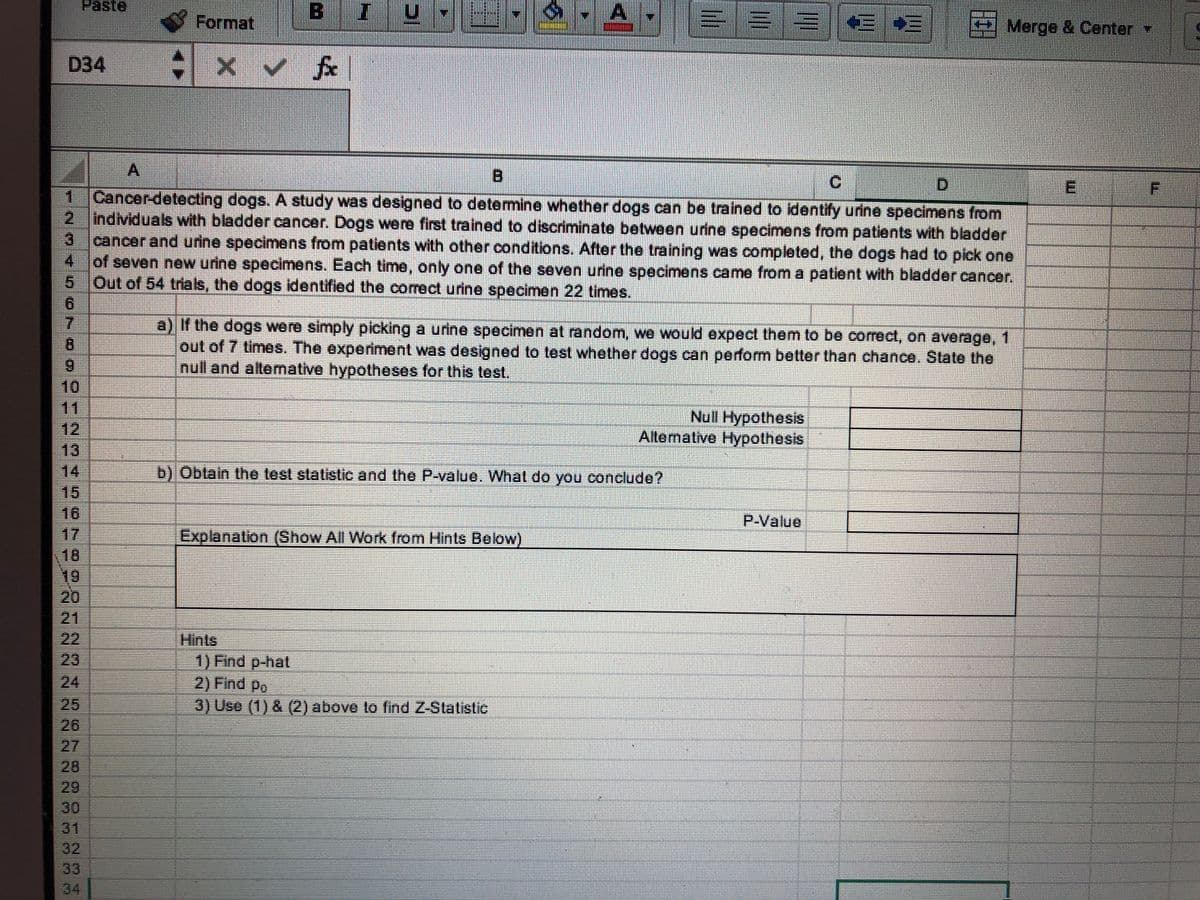Cancer-detecting dogs. A study was designed to detemine whether dogs can be trained to identify urine specimens from individuals with bladder cancer. Dogs were first trained to discriminate between urine specimens from patients with bladder cancer and urine specimens from patients with other conditions. After the training was completed, the dogs had to pick one of seven new urine specimens. Each time, only one of the seven urine specimens came from a patient with bladder cancer. Out of 54 trials, the dogs identified the correct urine specimen 22 times. a) If the dogs were simply picking a urine specimen at random, we would expect them to be correct, on average, 1 out of 7 times. The experiment was designed to test whether dogs can perform better than chance. State the null and altemative hypotheses for this test. Null Hypothesis Altenative Hypothesis b) Obtain the test statistic and the P-value. What do you conclude? P-Value Explanation (Show All Work from Hints Below) Hints 1) Find p-hat 2) Find po 3) Use (1) & (2) above to find Z-Statistic
Cancer-detecting dogs. A study was designed to detemine whether dogs can be trained to identify urine specimens from individuals with bladder cancer. Dogs were first trained to discriminate between urine specimens from patients with bladder cancer and urine specimens from patients with other conditions. After the training was completed, the dogs had to pick one of seven new urine specimens. Each time, only one of the seven urine specimens came from a patient with bladder cancer. Out of 54 trials, the dogs identified the correct urine specimen 22 times. a) If the dogs were simply picking a urine specimen at random, we would expect them to be correct, on average, 1 out of 7 times. The experiment was designed to test whether dogs can perform better than chance. State the null and altemative hypotheses for this test. Null Hypothesis Altenative Hypothesis b) Obtain the test statistic and the P-value. What do you conclude? P-Value Explanation (Show All Work from Hints Below) Hints 1) Find p-hat 2) Find po 3) Use (1) & (2) above to find Z-Statistic
Algebra & Trigonometry with Analytic Geometry
13th Edition
ISBN:9781133382119
Author:Swokowski
Publisher:Swokowski
Chapter10: Sequences, Series, And Probability
Section: Chapter Questions
Problem 24T
Related questions
Topic Video
Question

Transcribed Image Text:Paste
Format
2 Merge & Center
D34
C|x v fx
A.
C.
E.
1 Cancer-detecting dogs. A study was designed to determine whether dogs can be trained to identify urine specimens from
2 Individuals with bladder cancer. Dogs were first trained to discriminate between urine specimens from patients with bladder
cancer and urine specimens from patients with other conditions. After the training was completed, the dogs had to pick one
4 of seven new urine specimens. Each time, only one of the seven urine specimens came from a patient with bladder cancer.
5 Out of 54 trials, the dogs identified the correct urine specimen 22 times.
6.
7.
3.
a) If the dogs were simply picking a urine specimen at random, we would expect them to be correct, on average, 1
out of 7 times. The experiment was designed to test whether dogs can perform better than chance. State the
null and altemative hypotheses for this test.
B.
6.
10
11
12
13
14
15
16
Null Hypothesis
Alternative Hypothesis
b) Oblain the test statistic and the P-value. What do you conclude?
P-Value
17
18
Explanation (Show All Work from Hints Below)
19
20
21
22
23
Hints
1) Find p-hat
2) Find Po
3) Use (1) & (2) above to find Z-Statistic
24
25
26
27
28
29
30
31
32
33
34
Expert Solution
This question has been solved!
Explore an expertly crafted, step-by-step solution for a thorough understanding of key concepts.
This is a popular solution!
Trending now
This is a popular solution!
Step by step
Solved in 2 steps

Knowledge Booster
Learn more about
Need a deep-dive on the concept behind this application? Look no further. Learn more about this topic, statistics and related others by exploring similar questions and additional content below.Recommended textbooks for you

Algebra & Trigonometry with Analytic Geometry
Algebra
ISBN:
9781133382119
Author:
Swokowski
Publisher:
Cengage

Elementary Geometry for College Students
Geometry
ISBN:
9781285195698
Author:
Daniel C. Alexander, Geralyn M. Koeberlein
Publisher:
Cengage Learning

Algebra & Trigonometry with Analytic Geometry
Algebra
ISBN:
9781133382119
Author:
Swokowski
Publisher:
Cengage

Elementary Geometry for College Students
Geometry
ISBN:
9781285195698
Author:
Daniel C. Alexander, Geralyn M. Koeberlein
Publisher:
Cengage Learning